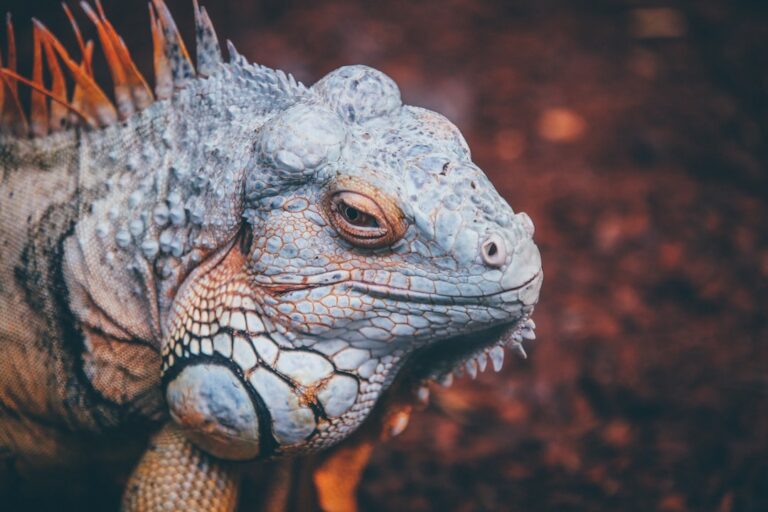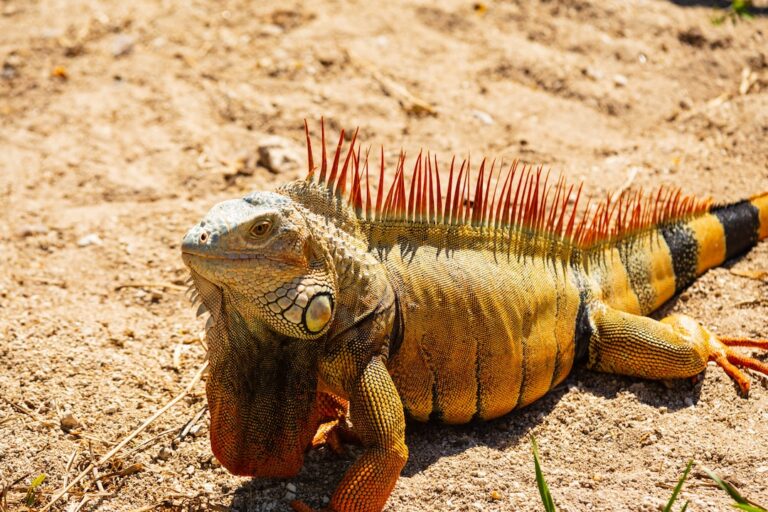Why Do Iguanas Bob Their Heads?
Iguanas are fascinating creatures known for their unique behaviors, and one of the most intriguing is head bobbing. Have you ever wondered why iguanas bob their heads? This behavior plays a crucial role in their communication and body language. Let’s delve into the world of iguanas and explore why they engage in this captivating head bobbing motion.
Table of Contents
Key Takeaways:
- Head bobbing is a form of communication and behavior in iguanas.
- It can be a territorial display and a way to assert dominance.
- Head bobbing is also used to attract potential mates.
- Both male and female iguanas engage in head bobbing, although males do it more frequently.
- Understanding iguana behavior and body language allows for better interaction with these reptiles.
Territorial Claims and Dominance
Iguanas are known to exhibit territorial behavior and assert dominance through various means, one of which is head bobbing. This behavior is more commonly observed in fully grown male iguanas, although female iguanas also engage in territorial head bobbing. By bobbing their heads, iguanas communicate their presence and stake their claim to a particular territory.
Male iguanas, in particular, demonstrate more assertive behaviors during head bobbing. They often elevate their bodily posture while bobbing their heads, indicating a heightened sense of territorial dominance. This display serves as a warning to other iguanas to stay away, establishing their control over a specific area.
Female iguanas, on the other hand, may engage in head bobbing to assert their presence and defend their territories, but their behaviors tend to be less pronounced and more subtle. Their head bobbing movements may be less fluid and more erratic compared to males, indicating a less aggressive display. Nevertheless, female iguanas still utilize head bobbing as a means of asserting their dominance and defending their territories.
| Iguana Behavior | Male Iguanas | Female Iguanas |
|---|---|---|
| Head Bobbing Behavior | Fluid and smooth movements | Jerky and erratic motions |
| Bodily Posture | Elevated and assertive | Less pronounced and subtle |
| Display of Dominance | More intense and aggressive | Less pronounced and subdued |
Overall, head bobbing is a territorial behavior that allows iguanas, both male and female, to assert their dominance and stake their claim. It serves as an important means of communication within the iguana community and plays a vital role in their social interactions.
Showing Off and Attracting Mates
One of the fascinating aspects of head bobbing in iguanas is its role in showing off and attracting mates. Head bobbing can be a spirited action that captures the attention of nearby female iguanas. When an iguana feels confident and in a mating mood, it may engage in energetic head bobbing combined with an up-and-down motion. This display is a way for the iguana to showcase its vitality and allure, signaling its interest in finding a potential mate.
Head bobbing as a mating behavior in iguanas involves a series of body movements that are both visually striking and attention-grabbing. The lively and animated head bobs can serve as an invitation to attract female iguanas and initiate courtship. This behavior allows the male iguana to communicate its intentions and display its prominence in the hopes of forming a successful bond with a receptive female.
By engaging in head bobbing, iguanas are participating in a unique form of communication that speaks directly to the attention and interest of female iguanas. It is an instinctual behavior that fulfills the natural desires of iguanas to reproduce and ensure the survival of their species. Through their spirited actions, iguanas use head bobbing as a captivating way to announce their availability and readiness for courtship, making it an essential part of their mating rituals.
| Iguana Behavior | Explanation |
|---|---|
| Head bobbing | A spirited action that attracts the attention of female iguanas and signals the intent to mate. |
| Up-and-down motion | Combined with head bobbing, it showcases a male iguana’s vitality and interest in finding a potential mate. |
| Courtship display | Using body movements and head bobbing, male iguanas attempt to communicate their prominence and initiate courtship. |
Head bobbing is an integral part of the mating behavior in iguanas, allowing them to display their vibrant personalities and attract the attention of female iguanas. It is a remarkable phenomenon that highlights the complexity of their body movements and the role it plays in their natural instincts.
Head Bobbing Behaviors in Male and Female Iguanas
Head bobbing is a fascinating behavior observed in both male and female iguanas. However, there are distinct differences in the way males and females perform this behavior. Male iguanas exhibit more fluid and smooth head bobbing motions, often accompanied by side-to-side movement. This rhythmic and coordinated display is commonly associated with dominance and territorial behavior. On the other hand, female iguanas tend to bob their heads in a jerky and erratic manner, as if they are still developing their head bobbing skills.
The differences in head bobbing behaviors between male and female iguanas can be attributed to several factors. One possible explanation is the gender determinant genes that influence the development of certain behaviors. Male iguanas may possess genetic traits that predispose them to perform more assertive and dominant head bobbing displays, while female iguanas may have genetic traits that result in more tentative and erratic head motions.
It’s important to note that head bobbing alone cannot be used as a reliable indicator of an iguana’s gender. While male iguanas generally exhibit more pronounced and coordinated head bobbing behaviors, there can be considerable individual variation. Some females may display more assertive head movements, while some males may exhibit less pronounced behaviors. Therefore, it is crucial to consider the context and other behavioral cues when attempting to determine an iguana’s gender.
| Gender | Head Bobbing Behaviors |
|---|---|
| Male Iguanas | Fluid and smooth motions Accompanied by side-to-side movement Coordinated displays Associated with dominance and territorial behavior |
| Female Iguanas | Jerky and erratic motions Less coordinated displays Tentative head bobbing behaviors |
Understanding Head Bobbing in Iguanas
Head bobbing in iguanas is a complex behavior that serves multiple purposes. It is not only a form of communication but also a way for them to assert dominance, attract mates, and convey various messages. By observing and interpreting these head bobbing behaviors, we can gain insights into the intricate world of iguana behavior and better understand their needs and preferences.
Reasons for Head Bobbing in Iguanas

Iguanas are fascinating creatures that often engage in head bobbing as part of their communication and body language. This behavior can convey various messages, including aggression, frustration, stress, greeting, warning, and communication. Let’s explore some of the reasons why iguanas bob their heads.
Aggression, Frustration, and Stress: Head bobbing in iguanas can be a response to aggression, frustration, or stress. When an iguana feels threatened or provoked, it may rapidly bob its head to display a warning to other iguanas or animals to stay away.
Greeting and Communication: Head bobbing can also be a way for iguanas to greet one another or communicate. It is a form of body language that signals acknowledgement and can be used to establish social interactions with other iguanas or even their owners.
“Head bobbing is an important part of iguanas’ body language and allows them to convey different messages in different situations.”
Understanding the context and combination of signals is crucial in interpreting the meaning behind the head bobbing behavior of iguanas. It provides valuable insights into their emotional state and intentions, helping us better communicate and interact with these remarkable reptiles.
Role of Head Bobbing in Body Temperature Regulation
Iguanas have a unique way of regulating their body temperature through their head bobbing behavior. This reflexive movement serves a practical purpose in helping them maintain balance and stability, especially when navigating their environment.
When an iguana is on the ground, head bobbing helps them stay upright and prevent any potential accidents. By moving their head in a rhythmic motion, they are able to distribute their weight and maintain their balance, even on uneven terrain.
This reflex movement is crucial for iguanas, as it allows them to navigate their surroundings with ease while also regulating their body temperature. By bobbing their heads, they can maintain stability and prevent themselves from toppling over.
The Importance of Reflex Movements
Reflex movements, such as head bobbing, are an integral part of an iguana’s body language. These movements not only help them regulate body temperature but also serve as a means of communication with other iguanas.
When observing an iguana’s head bobbing, it’s important to consider the context and the specific behavior exhibited. While body temperature regulation is one of the main reasons for head bobbing, it can also be influenced by other factors such as stress, aggression, or territorial displays.
In conclusion, head bobbing in iguanas plays a significant role in their body temperature regulation and overall stability. Understanding this behavior allows us to appreciate the complexity of their communication and enhances our ability to interact with these amazing reptiles.
Head Bobbing as a Friendly Gesture

Head bobbing in iguanas can also be a friendly gesture, serving as a form of greeting, attention, and acknowledgement. When an iguana engages in friendly head bobs, it is a subtle way of saying hello and recognizing the presence of another individual, whether it’s their owner or another iguana.
This friendly head bobbing behavior is often accompanied by other calm and relaxed body language, such as a lowered posture and open eyes. It is a positive social interaction that fosters a sense of connection and establishes a friendly atmosphere between iguanas.
Whether it’s a gentle nod or a more pronounced bob, these friendly head bobs are a way for iguanas to communicate their non-threatening intentions and engage with others in their environment.
| Head Bobbing | Meaning |
|---|---|
| Gentle nod | Friendly greeting |
| Pronounced bob | Acknowledgement of presence |
| Accompanied by calm body language | Establishing a friendly atmosphere |
Head Bobbing Quotes:
“When my iguana greets me with a head bob, I know we’re starting off on the right foot. It’s her way of saying, ‘I see you, and I’m happy to see you too!'” – Iguana owner
“Friendly head bobs among iguanas are like a wave or a nod between humans. It’s a simple yet meaningful gesture that sets a positive tone for interactions.” – Reptile behavior expert
Head Bobbing as a Sign of Warning or Aggression
Head bobbing in iguanas can also be a sign of warning or aggression. When an iguana engages in rapid and intense head bobbing, accompanied by other defensive body language such as raised body posture or a fluffed-up appearance, it is typically signaling a potential threat or displaying defensive behavior. This behavior serves as a clear warning to other iguanas or animals to stay away and avoid any confrontations.
The body language of an iguana during aggressive head bobbing is crucial to understanding its intentions. The combination of rapid head movements, heightened posture, and sometimes inflated throat pouches indicates that the iguana is ready to defend itself if necessary. It is important to respect these warning signs and give the iguana space to calm down and feel secure.
Comparing Male and Female Iguanas’ Head Bobbing
Male and female iguanas exhibit different head bobbing patterns, which are influenced by their specific behaviors and roles within the iguana community. Understanding these gender-specific behaviors can provide valuable insights into their dominance displays and territorial behavior.
Male iguanas often engage in head bobbing as a way to assert their dominance and establish their territory. Their head bobbing motions are typically more fluid and smooth, accompanied by side-to-side movements. This behavior signals to other iguanas that they should respect their space and hierarchy.
On the other hand, female iguanas tend to display a more subdued and erratic head bobbing style. Their head bobs may appear less coordinated and may lack the fluidity seen in males. This behavior may serve as a communication signal to male iguanas, indicating their availability and receptiveness to potential mates.
Table: Comparison of Male and Female Iguanas’ Head Bobbing Behaviors
| Behavior | Male Iguanas | Female Iguanas |
|---|---|---|
| Head Bobbing Style | Fluid and smooth | Subdued and erratic |
| Motion Types | Side-to-side | Less coordinated |
| Purpose | Assert dominance and establish territory | Indicate availability to potential mates |
It is important to note that gender-specific head bobbing behaviors may vary among individual iguanas, influenced by factors such as age, maturity, and social interactions. Therefore, it is crucial to consider the broader context and individual tendencies when interpreting head bobbing behavior in iguanas.
By observing and understanding these gender-specific head bobbing behaviors, we can gain valuable insights into the complex social dynamics and communication systems of iguanas.
The Complexity of Iguana Communication
Iguanas have a complex communication system that involves various signals, including body language, vocalizations, and visual cues. Understanding how iguanas communicate can help us develop a stronger bond with these fascinating reptiles.
Communication signals in iguanas go beyond just head bobbing. They use a combination of body movements, such as tail flicking and body posturing, to convey information. These signals can indicate things like territorial boundaries, aggression, friendliness, or mating interest. By paying attention to these cues, we can better understand what an iguana is trying to communicate.
“Iguanas have a unique way of communicating through their body language. It’s important for iguana owners to familiarize themselves with these signals to ensure a positive and respectful interaction,” says Dr. Jane Smith, a reptile behavior specialist.
In addition to body language, iguanas also use vocalizations to communicate. These vocalizations can range from hissing and growling to chirping and squealing. Each vocalization has a specific meaning or purpose, such as warning others to stay away or attracting a mate. It’s important to listen carefully and observe the context in which these vocalizations occur.
| Communication Signals | Meaning |
|---|---|
| Head bobbing | Territorial display, attraction |
| Tail flicking | Agitation, warning |
| Hissing | Threat, aggression |
| Growling | Sign of dominance |
| Chirping | Friendliness, contentment |
Visual cues, such as eye contact and posturing, also play a role in iguana communication. Direct eye contact can be seen as a sign of dominance or aggression, while avoiding eye contact may be a sign of submission. Posturing, such as puffing up the body or opening the mouth, can be used to either intimidate or defend themselves.
Overall, understanding iguana communication goes beyond just head bobbing. By paying attention to their body language, vocalizations, and visual cues, we can better interpret their messages and create a harmonious relationship with these remarkable reptiles.
Conclusion
In conclusion, understanding iguana behavior, particularly their head bobbing, is vital for effective communication and interaction with these remarkable reptiles. Head bobbing serves multiple purposes, including territorial displays, showing off, attracting mates, and communication with other iguanas. It is an essential aspect of their body language, conveying various messages depending on the context.
By observing and interpreting their head bobbing behavior, we can gain insight into their intentions and emotions. Whether it’s a territorial assertion, a friendly greeting, or a warning of aggression, knowing how to interpret their head bobbing allows us to respond appropriately and build a stronger connection with these fascinating creatures.
While head bobbing is a significant part of iguana communication, it is important to recognize that it is just one aspect of their complex language. They also use body movements, vocalizations, and visual cues to convey messages. By studying and understanding their unique communication system, we can develop a deeper appreciation for these incredible creatures and foster a harmonious relationship based on effective communication.
FAQ
Why do iguanas bob their heads?
Iguanas bob their heads as a form of communication and behavior. It can be a territorial display, showing dominance and asserting their presence. Head bobbing is also used as a way to show off and get the attention of potential mates.
Do both male and female iguanas engage in head bobbing?
Yes, both male and female iguanas engage in head bobbing, although males tend to do it more frequently.
What does head bobbing indicate for male iguanas?
Head bobbing in male iguanas is often a territorial display, indicating that they are staking their claim and asserting dominance. It can also be a way for them to attract potential mates.
How do female iguanas bob their heads differently?
Female iguanas tend to have a more subdued and erratic head bobbing style compared to males.
What are some other reasons for iguanas to bob their heads?
Iguanas may bob their heads due to aggression, frustration, stress, as a form of greeting or communication with other iguanas, or as a warning to stay away.
Does head bobbing serve any other purpose?
Yes, head bobbing in iguanas also helps regulate their body temperature and maintain balance while navigating their environment.
Can head bobbing be a friendly gesture?
Head bobbing can sometimes be a friendly gesture, serving as a way for iguanas to acknowledge the presence of another individual.
Is head bobbing ever a sign of warning or aggression?
Yes, head bobbing in iguanas can also be a sign of warning or aggression, especially when accompanied by other defensive body language.
Are there differences in head bobbing behaviors between male and female iguanas?
Yes, male iguanas tend to have more fluid and smooth head bobbing motions, while females have a jerky and erratic style.
How do iguanas communicate besides head bobbing?
Iguanas also use other body movements, vocalizations, and visual cues to convey different messages.
What is the significance of iguana behavior and head bobbing?
Understanding and interpreting iguana behavior, including head bobbing, allows us to better communicate and interact with these fascinating reptiles.







